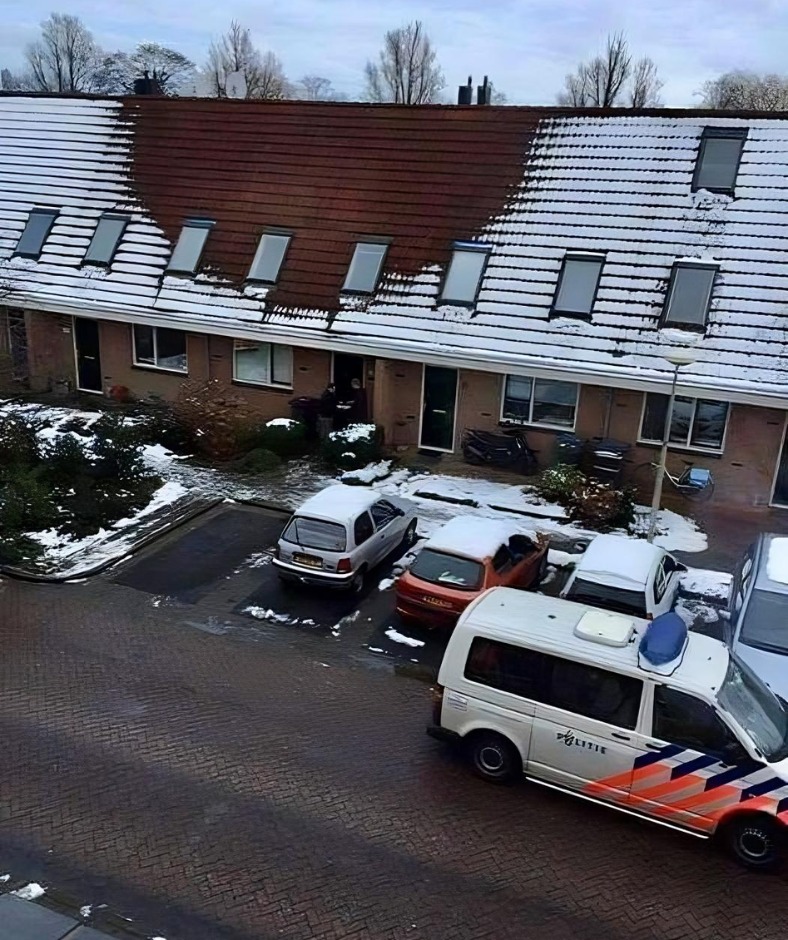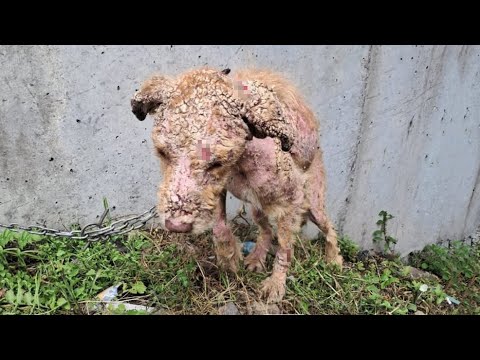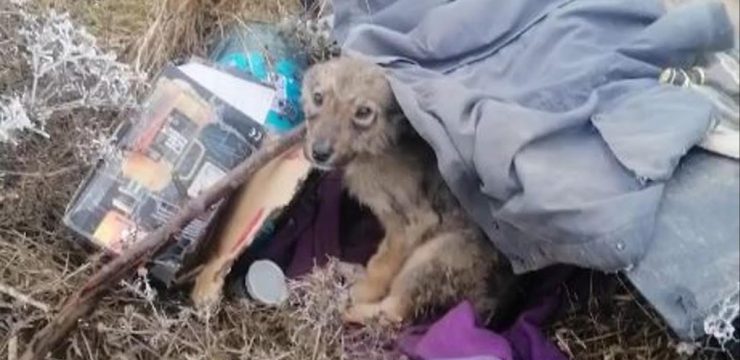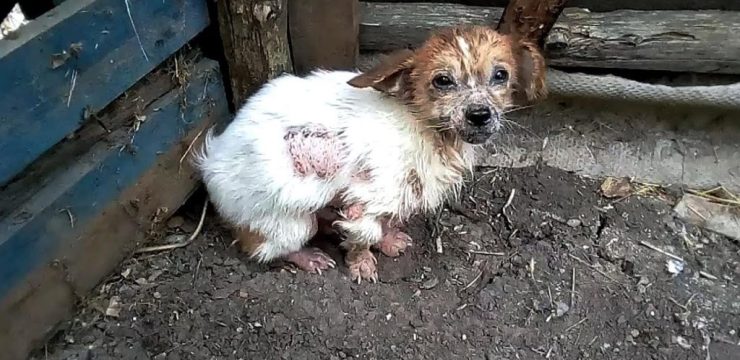Snow blanketed the Netherlands, transforming towns and villages into postcard-perfect winter scenes. Streets shimmered in white, rooftops glistened under the pale sun, and the air carried the crisp stillness of a frozen morning. For most villagers, it was a peaceful and familiar sight—except for one peculiar house that refused to blend in. While every rooftop in the small Dutch village was covered in a thick layer of snow, this particular home stood out with a completely bare roof.

At first, no one paid much attention. The locals brushed it off as nothing unusual. Perhaps, they thought, the homeowners were doing some renovations. Maybe they had installed a modern heating system or new roof insulation. “Who knows?” people would say, chuckling over their morning coffee.
But as the snowstorms continued and the white blanket deepened across the village, one thing remained constant—the roof of that house never caught a single flake. Snow kept piling up everywhere else, and yet that one spot stood dark and dry. Soon, whispers spread through the community. It didn’t take long for curiosity to turn into suspicion.
Eventually, the villagers decided to alert the local authorities. And that call changed everything.
The Dutch police, upon hearing the report, immediately knew what they might be dealing with. In the Netherlands, a snow-free roof in the middle of winter isn’t just an architectural mystery—it can be a telltale sign of something far more serious.
According to law enforcement officials, when a roof stays warm enough to melt snow as soon as it falls, it often means there’s an unusual amount of heat coming from inside the house. And that kind of heat is typically associated with one specific activity: large-scale indoor cannabis cultivation.
Police in Haarlem and other cities had seen this pattern before. The “snow-free roof” had become a subtle but effective red flag in uncovering illegal grow operations.
Growing cannabis indoors requires strong artificial lighting, powerful ventilation systems, and consistent heat to mimic tropical conditions. Those high-intensity lamps and heaters generate enormous amounts of warmth. That heat doesn’t just stay contained—it rises and escapes through the ceiling and roof, quickly melting snow even in sub-zero weather. To law enforcement, it’s like nature providing its own version of a thermal imaging system.
When officers arrived at the suspicious home, they didn’t have to look far to confirm their suspicions. Inside, they found a fully operational cannabis farm. Rows of plants stretched across several rooms, bathed in the glow of industrial lamps. The air was thick with humidity and carried a strong, unmistakable odor. Sophisticated ventilation ducts lined the ceilings, pumping out hot air around the clock.
The heat produced by the equipment was so intense that snow simply couldn’t accumulate on the roof—revealing the homeowner’s secret operation to the entire neighborhood.
Authorities later confirmed that this wasn’t an isolated incident. Similar discoveries had been made in other Dutch towns, including Zutphen and Arnhem. In each case, snow-free rooftops had tipped off officers to investigate further. What they found inside varied from modest setups with around 80 to 100 plants to larger-scale operations producing up to 500 plants worth nearly €50,000.
Following these cases, the Dutch police decided to use the unusual pattern to their advantage. Through social media and local news outlets, they encouraged residents to report any snow-free roofs during winter months. “Sometimes,” one officer remarked, “the snow tells you more than the neighbors ever could.”
The campaign quickly gained traction. Citizens were reminded that while the Netherlands is known globally for its tolerant approach toward cannabis, that tolerance has strict boundaries. Contrary to popular belief, the country does not permit large-scale marijuana production.
Under Dutch law, adults may possess up to five grams of cannabis for personal use and may purchase it from licensed coffee shops. However, cultivating more than five plants—or growing for commercial purposes—is strictly prohibited. Any form of large-scale cultivation is considered drug trafficking and can result in serious criminal charges, including imprisonment and hefty fines.
The distinction lies between regulated tolerance and illegal enterprise. Coffee shops operate under strict conditions and cannot grow their own supplies; they must source cannabis through controlled channels. Yet, due to the demand and the gap between policy and supply, underground growers often take the risk—transforming homes, warehouses, and even greenhouses into secret plantations.
Authorities have long battled these illicit farms, not only because of the legal implications but also because of the safety hazards they pose. Indoor cannabis farms consume massive amounts of electricity, often through illegal wiring that bypasses meters. This can lead to dangerous overheating and even house fires. In some neighborhoods, entire electrical grids have been disrupted due to overloaded circuits caused by hidden grow rooms.
In the case of the snow-free roof, investigators later confirmed that the electrical setup had been tampered with to avoid detection. The risk wasn’t just financial—it was a potential disaster waiting to happen.
For the villagers, the discovery was both shocking and eye-opening. What seemed like an innocent mystery about a strange roof had unveiled an illegal operation right in their midst. It reminded everyone how sometimes, the smallest details—like a patch of missing snow—can reveal a much bigger story.
In the aftermath, the local police used the case as an educational example, emphasizing the importance of community awareness. They encouraged citizens to remain observant and report suspicious signs—not just for law enforcement’s sake, but for public safety.
Across the country, similar investigations followed, especially after heavy snowfalls. The pattern became so consistent that Dutch authorities began referring to winter as their “season of discovery.” Each snow-free roof potentially pointed to another illegal grow operation hidden in plain sight.
While the Netherlands continues to be associated with its progressive approach to cannabis, the reality is more complex. The balance between tolerance and legality requires constant vigilance. This case served as a reminder that even in a country known for its open-minded policies, the law still draws a firm line when it comes to illegal cultivation.
As one Haarlem police officer put it, “Snow doesn’t lie. If your roof stays warm in the middle of winter, we’re going to want to know why.”
It’s a clever example of how nature and law enforcement sometimes work hand in hand. When it comes to crime, even the weather can reveal what people try to hide.
So, the next time you stroll through a quiet winter village and see one roof standing out among the rest, remember: sometimes, what’s missing says more than what’s there.
Please share this story with your friends and family on Facebook — it might just melt away a few more mysteries.





